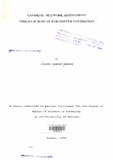| dc.description.abstract | The classical estimation procedures, such as least
squares approach, tised to estimate parameters in geodetic
network adjustment, take into consideration several
assumptions about normality and independence of observational
errors, distribution models, and prior distribution for
certain parameters. In the event that the assumptions do not
hold, owing to the presence of gross errors, the classical
procedures loose efficiency drastically.
To circumvent the difficulty of estimating under such
circumstances, robust estimation procedures that can
accommodate gross errors have been put forward. Robust
estimation procedures are supposed to proceed safely despite
the presence of gross errors and yield estimates that are
largely not affected by the gross errors.
The present study considers four robust estimation
techniques as appIied in the estimation of geodetic
parameters. The procedures have been referred to as; iterative
weiqhtinq approach, location step with modified residua Is,
location step with modified weights, and combined approach.
In th i"~ atlv weighing approach, observation
weights are considered as functions of both variances and
residuals I where the weights are derived in an alternative
procedure. The location step with modified residuals is based
on the minimisation of the residuals in a winsorized version
instead of minimising as usual the sum of the squares of the
residuals. The location step with modified weights considers
the whights as functions of the winsorized residuals with the
weights thus obtained iteratively. The combined approach
adopts the estimate of the modified residuals approach as the
initial values for the modified weights approach.
The techniques are used to estimate geodetic network
parameters when the observations are considered to be gross
error.free and when they are considered to be contaminated
with gross errors. Through the analysis of the results with
each technique, the effectiveness of estimation with each of
the techniques --when there are gross errors could be established.
To test the validity of the models under study, a
simulated test network that consisted of 19 points, 42
distances and 84 directions has been considered. In the test
network outliers were simulated both in distances and
directions, and the network adjusted on the basis of free network
solution, first with gross error free observations and
then, with the observations considered to have gross errors.
The results indicate that the robust estimation models,
in general result in much more efficient estimates than
ordinary least squares when observations are contaminated with
gross errors. The I iterative weighting approach performed
extremely well and was most robust with respect to gross error
contaminated observations. The performance of the other robust
estimation models, in the order of robustness were; the
combined approach, modified weights approach, and the modified
residual approach. | en |

